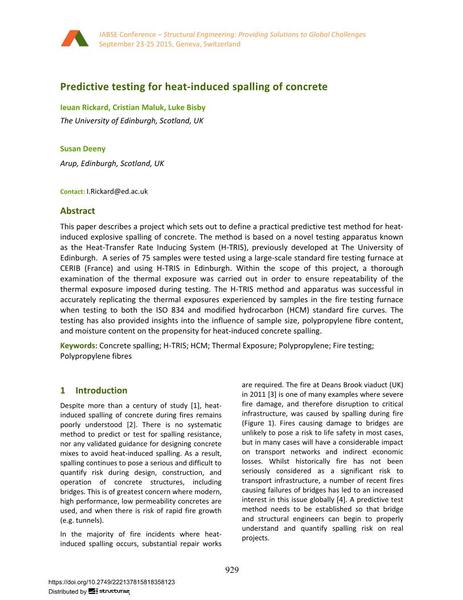Predictive testing for heat-induced spalling of concrete

|
|
|||||||||||
Bibliographic Details
| Author(s): |
Ieuan Rickard
(The University of Edinburgh, Scotland, UK)
Cristián Maluk (The University of Edinburgh, Scotland, UK) Luke Bisby (The University of Edinburgh, Scotland, UK) Susan Deeny (Arup, Edinburgh, Scotland, UK) |
||||
|---|---|---|---|---|---|
| Medium: | conference paper | ||||
| Language(s): | English | ||||
| Conference: | IABSE Conference: Structural Engineering: Providing Solutions to Global Challenges, Geneva, Switzerland, September 2015 | ||||
| Published in: | IABSE Conference Geneva 2015 | ||||
|
|||||
| Page(s): | 929-936 | ||||
| Total no. of pages: | 8 | ||||
| Year: | 2015 | ||||
| DOI: | 10.2749/222137815818358123 | ||||
| Abstract: |
This paper describes a project which sets out to define a practical predictive test method for heat- induced explosive spalling of concrete. The method is based on a novel testing apparatus known as the Heat-Transfer Rate Inducing System (H-TRIS), previously developed at The University of Edinburgh. A series of 75 samples were tested using a large-scale standard fire testing furnace at CERIB (France) and using H-TRIS in Edinburgh. Within the scope of this project, a thorough examination of the thermal exposure was carried out in order to ensure repeatability of the thermal exposure imposed during testing. The H-TRIS method and apparatus was successful in accurately replicating the thermal exposures experienced by samples in the fire testing furnace when testing to both the ISO 834 and modified hydrocarbon (HCM) standard fire curves. The testing has also provided insights into the influence of sample size, polypropylene fibre content, and moisture content on the propensity for heat-induced concrete spalling. |
||||
| Keywords: |
polypropylene fibres concrete spalling polypropylene H-TRIS HCM Thermal Exposure fire testing
|
||||
